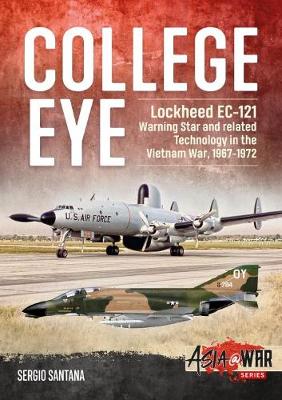Asia@War
1 total work
During the Cuban Missile Crisis of 1962, the National Security Agency (NSA) of the USA realized that it was capable of reading transmissions emitted by SRO-2 identification friend or foe (IFF) transponders carried by Soviet-made combat aircraft airborne over Cuba.
After several years of development work, the resulting technology was installed in the form of the QRC-248 enemy IFF-interrogator system into Lockheed EC-121 Warning Star airborne early warning (AEW) aircraft deployed in support of US operations over North Vietnam, in 1967, within the Project code-named College Eye.
While deployed with extreme caution in order to safeguard 'intelligence sources' - and thus remaining dependent on the North Vietnamese pilots activating their IFF transponders - the QRC-248 proved a true 'eye-opener' for the Americans involved: all of a sudden, College Eye's EC-121s became capable of accurately discriminating low-flying MiGs from the myriad returns picked up by their long-range radars, and detecting these from a range out to 170 miles.
Project College Eye was further intensified and the QRC-248 made capable of reading transmissions from two additional Soviet transponders, the SRO-1 and the SOD-57 (Project Rivet Top). Combined with the addition of on-board Vietnamese linguists capable of listening to and translating the radio transmissions from North Vietnamese fighter-pilots in real time (Project Rivet Gym), suitably equipped EC-121s became the lynchpins in the US aerial warfare strategy.
Meanwhile, the miniaturized version of the QRC-248 - the APX-80 Combat Tree enemy IFF-interrogator - was installed into a handful of McDonnell Douglas F-4D Phantom II interceptors of the US Air Force. The fighters in question scored some of the most spectacular air combat victories in the Vietnam War of 1971-1972; they also suffered some of the most painful losses.
Telling a little-known story, yet of crucial importance for the flow of the air war over North Vietnam, College Eye provides rare insights into the development, operational deployment, and combat operations of a relatively small community of US airmen: a story about what eventually evolved into the 'Mother of modern-day AWACS aircraft'.
After several years of development work, the resulting technology was installed in the form of the QRC-248 enemy IFF-interrogator system into Lockheed EC-121 Warning Star airborne early warning (AEW) aircraft deployed in support of US operations over North Vietnam, in 1967, within the Project code-named College Eye.
While deployed with extreme caution in order to safeguard 'intelligence sources' - and thus remaining dependent on the North Vietnamese pilots activating their IFF transponders - the QRC-248 proved a true 'eye-opener' for the Americans involved: all of a sudden, College Eye's EC-121s became capable of accurately discriminating low-flying MiGs from the myriad returns picked up by their long-range radars, and detecting these from a range out to 170 miles.
Project College Eye was further intensified and the QRC-248 made capable of reading transmissions from two additional Soviet transponders, the SRO-1 and the SOD-57 (Project Rivet Top). Combined with the addition of on-board Vietnamese linguists capable of listening to and translating the radio transmissions from North Vietnamese fighter-pilots in real time (Project Rivet Gym), suitably equipped EC-121s became the lynchpins in the US aerial warfare strategy.
Meanwhile, the miniaturized version of the QRC-248 - the APX-80 Combat Tree enemy IFF-interrogator - was installed into a handful of McDonnell Douglas F-4D Phantom II interceptors of the US Air Force. The fighters in question scored some of the most spectacular air combat victories in the Vietnam War of 1971-1972; they also suffered some of the most painful losses.
Telling a little-known story, yet of crucial importance for the flow of the air war over North Vietnam, College Eye provides rare insights into the development, operational deployment, and combat operations of a relatively small community of US airmen: a story about what eventually evolved into the 'Mother of modern-day AWACS aircraft'.
